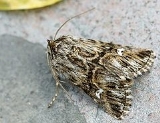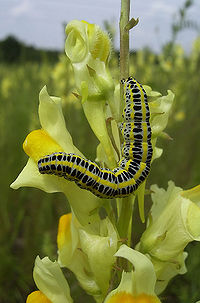
Calophasia lunula
Encyclopedia
Calophasia lunula is a species of noctuid moth
known by the common names toadflax moth and toadflax brocade moth. It is used as an agent of biological pest control
against yellow toadflax
(Linaria vulgaris) and Dalmatian toadflax (Linaria genistifolia ssp. dalmatica) in areas where they are considered noxious weeds
, such as in North America.
 The adult is a hairy gray moth about 12 millimeters long. The female lays anywhere from 30 to 80 eggs on the leaves and flowers of toadflax plants. In one to two weeks the larva
The adult is a hairy gray moth about 12 millimeters long. The female lays anywhere from 30 to 80 eggs on the leaves and flowers of toadflax plants. In one to two weeks the larva
emerges from the egg and begins feeding. This caterpillar
undergoes five molts
during a one-month period. The first-stage larva is about 5 millimeters long and dark gray in color. The eyecatching older larvae are black and white spotted with bright yellow stripes. The mature larva is about 4 centimeters long. After this stage it pupa
tes through the winter in a cocoon of chewed plant matter and leaf litter.
Damage to the plants is done by the voracious feeding of the caterpillars. They consume all the new leaf and flower buds first and then move on to eat stems, leaves, and flowers, often to the point of complete defoliation of large numbers of toadflax plants. This does not necessarily kill the plants but it severely reduces their ability to produce seeds and propagate. Adults feed harmlessly on the plants' nectar and do not contribute to the damage.
This moth is native to Europe. It was first introduced to Canada as a biocontrol agent in the early 1960s, and to the United States shortly thereafter. The moth is now established in many areas. It tends not to establish as easily in colder climates.
Noctuidae
The Noctuidae or owlet moths are a family of robustly-built moths that includes more than 35,000 known species out of possibly 100,000 total, in more than 4,200 genera. They constitute the largest family in the Lepidoptera....
known by the common names toadflax moth and toadflax brocade moth. It is used as an agent of biological pest control
Biological pest control
Biological control of pests in agriculture is a method of controlling pests that relies on predation, parasitism, herbivory, or other natural mechanisms...
against yellow toadflax
Linaria vulgaris
Linaria vulgaris is a species of toadflax , native to most of Europe and northern Asia, from the United Kingdom south to Spain in the west, and east to eastern Siberia and western China...
(Linaria vulgaris) and Dalmatian toadflax (Linaria genistifolia ssp. dalmatica) in areas where they are considered noxious weeds
Noxious weeds
A noxious weed is an invasive species of a plant that has been designated by country, state or provincial, or national agricultural authorities as one that is injurious to agricultural and/or horticultural crops, natural habitats and/or ecosystems, and/or humans or livestock...
, such as in North America.

Larva
A larva is a distinct juvenile form many animals undergo before metamorphosis into adults. Animals with indirect development such as insects, amphibians, or cnidarians typically have a larval phase of their life cycle...
emerges from the egg and begins feeding. This caterpillar
Caterpillar
Caterpillars are the larval form of members of the order Lepidoptera . They are mostly herbivorous in food habit, although some species are insectivorous. Caterpillars are voracious feeders and many of them are considered to be pests in agriculture...
undergoes five molts
Ecdysis
Ecdysis is the moulting of the cuticula in many invertebrates. This process of moulting is the defining feature of the clade Ecdysozoa, comprising the arthropods, nematodes, velvet worms, horsehair worms, rotifers, tardigrades and Cephalorhyncha...
during a one-month period. The first-stage larva is about 5 millimeters long and dark gray in color. The eyecatching older larvae are black and white spotted with bright yellow stripes. The mature larva is about 4 centimeters long. After this stage it pupa
Pupa
A pupa is the life stage of some insects undergoing transformation. The pupal stage is found only in holometabolous insects, those that undergo a complete metamorphosis, going through four life stages; embryo, larva, pupa and imago...
tes through the winter in a cocoon of chewed plant matter and leaf litter.
Damage to the plants is done by the voracious feeding of the caterpillars. They consume all the new leaf and flower buds first and then move on to eat stems, leaves, and flowers, often to the point of complete defoliation of large numbers of toadflax plants. This does not necessarily kill the plants but it severely reduces their ability to produce seeds and propagate. Adults feed harmlessly on the plants' nectar and do not contribute to the damage.
This moth is native to Europe. It was first introduced to Canada as a biocontrol agent in the early 1960s, and to the United States shortly thereafter. The moth is now established in many areas. It tends not to establish as easily in colder climates.

